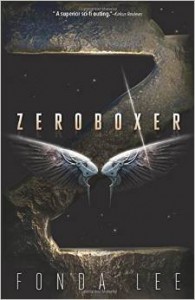Carr “The Raptor” Luka lives in deep orbit on the far side of the moon on an inner ring of Valtego Station. Although he’s from Earth, he has come to Valtego Station to train in the sport of zeroboxing. Using a combination of boxing, martial arts, and wrestling moves, a zeroboxer fights inside a Cube in zero gravity conditions. Similar to the mixed martial arts of cage fighting, zeroboxing receives some of the same criticism and is surrounded by similar controversy as that we see in contemporary times. But that controversy is not central to Fonda Lee’s debut science fiction, sports novel, Zeroboxer. Instead, the author chooses to focus on the possibility of human genetic enhancement in sports, and the story she spins is riveting.
At seventeen years old, Carr creates a sensation as the youngest zeroboxer to show such exquisite skill in the Cube. Athletically gifted, ambitious, intelligent, and more emotionally stable than is “typical for a man who makes a living with his fists” (49), Carr soon finds himself a champion at the center of a maelstrom. Because he is young, attractive, and an ethnic mash-up, he becomes the target of Zero Gravity Fight Association (ZGFA) officials who decide they want Carr as their poster athlete. A promotion company that features top-ranked fighters, the ZGFA is to zeroboxing what the Ultimate Fighting Championship (UFC) is to mixed martial arts.
Burdened with decisions and expectations, Carr is assigne d a brandhelm, whose focus is to grow awareness and popularity of the sport. Risha Ponn, a half-Martian rookie, is given the task of promoting the sport and marketing Carr’s athletic prowess. But because she is deliberately engineered—genetically modified so that she can adapt to conditions on Mars—she is the target of scorn from those who accept that gene therapy saves lives but that genetic enhancement should never be legal because “racism, wars, and genocide all spring from the idea of certain people being better than others” (96). As Risha gives Carr wings, he gradually falls in love with her, and his life grows more complicated because during the novel’s time period, the issue of genetic enhancement versus genetic therapy has polarized society. Carr lives in a world where no one has to wear genetic deficiencies “like a public mark of shame” (185) provided they have the resources for gene therapy. Given the polarity of this issue, an employer can run a check to verify that one’s genetic profile is “within legally acceptable ranges, but the full profile, listing which brand and version of chromosomal packages you were born with could only be obtained with consent” (123).
d a brandhelm, whose focus is to grow awareness and popularity of the sport. Risha Ponn, a half-Martian rookie, is given the task of promoting the sport and marketing Carr’s athletic prowess. But because she is deliberately engineered—genetically modified so that she can adapt to conditions on Mars—she is the target of scorn from those who accept that gene therapy saves lives but that genetic enhancement should never be legal because “racism, wars, and genocide all spring from the idea of certain people being better than others” (96). As Risha gives Carr wings, he gradually falls in love with her, and his life grows more complicated because during the novel’s time period, the issue of genetic enhancement versus genetic therapy has polarized society. Carr lives in a world where no one has to wear genetic deficiencies “like a public mark of shame” (185) provided they have the resources for gene therapy. Given the polarity of this issue, an employer can run a check to verify that one’s genetic profile is “within legally acceptable ranges, but the full profile, listing which brand and version of chromosomal packages you were born with could only be obtained with consent” (123).
The issue further complicates Carr’s life when he learns a secret about his own genetic makeup and becomes a target for Genepol, a government organization that investigates genetic crimes. Bound to a criminal pact when “he was nothing more than a bundle of cells in a petri dish” (156), Carr befriends fear in a very new way, and he has to redefine who he is and what he wants. The battle takes its toll on his relationships with his mother, his coach, and his friends.
- Posted by Donna
Besides his opponents in the Cube, Carr has to fight fame, corruption, and temptation. Corrosive and suffocating, claustrophobic stress swells to psychologically unmanageable dimensions as Carr works to resolve whether he is he a profit generator or a person. In his fight to shape his identity, to show himself to the world in his own way, and to stand for something worthy, Carr realizes “sometimes you can’t win, but you can decide not to lose” (343).

